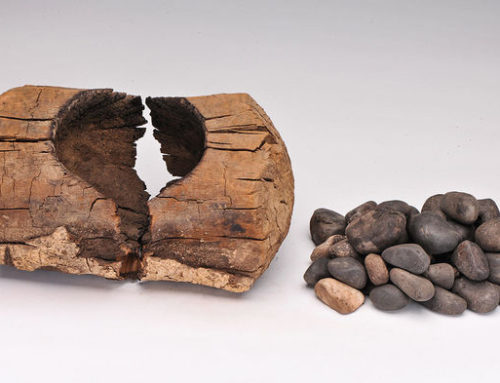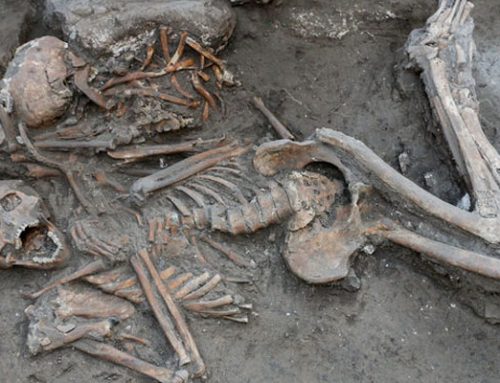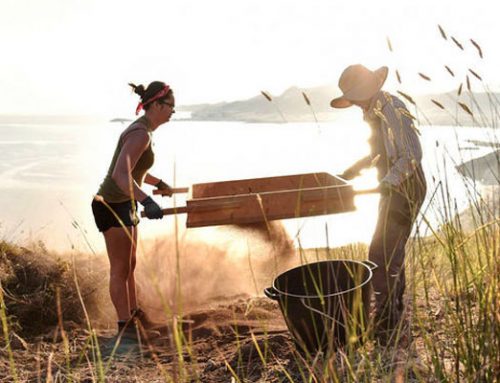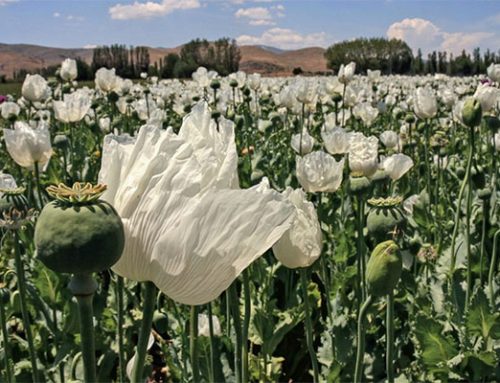As the world’s first civilizations emerged in the 3rd millennium B.C.E., an obscure region in eastern Arabia served as a crucial trade link while developing a surprisingly sophisticated independent culture of its own
BAT, OMAN—To a layperson, the three broken bits of red-and-black pottery, which fit in the palm of one hand, all look similar. But for 31-year-old archaeologist Chris Thornton, each piece tells a remarkable and distinct story of the time when humans first began to travel and trade over a vast area. One angular piece shows that some 4500 years ago, traders carrying pots created across the sea in Iran’s distant Kerman Province came to this small oasis in a remote corner of Oman in southeastern Arabia. A second piece hails all the way from the Indus River civilization, some 1500 kilometers to the east. And the third piece is a local imitation of the imported Indusware, not quite as sophisticated as the original. The modest sherds are clear evidence that in the 3rd millennium B.C.E., this dry and rugged region of the Arabian Peninsula was an important trading crossroads.
Clues like these are remaking our understanding of the first civilizations and the networks that bound them together. The urban centers of Mesopotamia, Iran, and the Indus River were connected in a web encompassing much of southern Asia, including places like Bat that were long considered backwaters. “This is a quite dynamic world fi lled with people moving about,” says archaeologist Gregory Possehl of the University of Pennsylvania, who directs the dig at Bat. “There were a number of chainlike networks. The whole place was quite lively.”
That’s a far cry from the traditional view in which the world’s first civilizations— Egypt, Mesopotamia, and the Indus—were largely isolated by sparsely populated deserts, seas, and mountains. Recent digs in Iran and Central Asia, however, have uncovered a plethora of ancient cities that traded goods and technologies overland with one another and their more famous neighbors (Science, 3 August 2007, p. 586). Now discoveries in Oman and the neighboring United Arab Emirates (UAE) are beginning to show that there was a southern sea route as well, which funneled raw materials such as copper and manufactured goods such as textiles across the Arabian Sea and the Persian Gulf.
 |
| Trading place. Arabia was perfectly positioned to be the linchpin of trade among the world’s first great civilizations. |
Those links reached deep into the eastern Arabian Peninsula to sites such as Bat, a modest settlement that by 2400 B.C.E. boasted massive round stone towers and tombs, a clever system to manage scarce water, and exotic goods.
Much is still unknown, including whether Indus traders actually penetrated deep into Arabia, the identities of the sailors who first plied the Indian Ocean, and just how extensive that contact was. But clues continue to emerge from numerous archaeological digs in Oman and the UAE, a region that has become a hotbed of excavation (see p. 1098). Work here and in the western Persian Gulf, Iran, Pakistan, and India reveals that this early Arabian culture was a nexus point for the far-fl ung civilizations of the 3rd millennium B.C.E. “Arabia is the hinge,” says Maurizio Tosi, an archaeologist at the University of Bologna in Italy who has conducted pioneering work in the region.
Sailing away While vacationing in 1981 on a cliff-ringed beach on the easternmost cape of Arabia, 200 kilometers east of Bat, Tosi stumbled on a 4500-year-old settlement. Over the next decade, he and his late colleague Serge Cleuziou of CNRS in Paris dug the site, called R’as al Jinz, and eventually uncovered ivory combs and potsherds marked with distinctive signs from the Indus River civilization, all buried in a modest mud-brick house.
They also excavated lumps of bitumen, an oil-based substance common in Mesopotamia, covered in barnacles. One piece still had the impressions of rope. The bitumen provided convincing proof for oceangoing boats made from reeds or planks sewn together and slathered with the imported waterproof substance—at the astonishingly early date of 2200 B.C.E. Excavators also found a piece of broken pottery chemically determined to come from Mesopotamia. Thus this single site demonstrated maritime connections with the two largest civilizations of the day.
 |
| Tomb rater. At R’as al Hadd, Cattani seeks clues to Arabia’s great transformation. |
The finds stunned archaeologists, who had long assumed that mariners did not master the secrets of the Indian Ocean’s monsoon winds until 1000 or more years later (see p. 1094). And it forced them to rethink trade connections between the Indus and its western neighbors. When the evidence was presented at a meeting in the early 1980s, “it was a very dramatic moment,” recalls New York University’s Rita Wright. “We were all dumbfounded.”
The discovery put the spotlight on an area mostly neglected by archaeologists. But given its modest houses and size, R’as al Jinz was almost certainly a fi shing village rather than an international port. So where did ships from the Indus dock? To find out, researchers have moved a short drive up the dramatic coast to a series of sites at R’as al Hadd, where they are finding even earlier settlements.
Current excavations by Maurizio Cattani, also from the University of Bologna, are exposing a rudimentary settlement dating back to the end of the 4th millennium B.C.E. By 3000 B.C.E.— centuries before Indus goods arrived at R’as al Jinz—the inhabitants here suddenly enclosed a 60-meter-by-40-meter area with a 1.5-meter-high stone wall. The settlers imported clay for their fl oors and built mud-brick structures using bricks of identical size to those at Hili, a distant oasis town just west of the Oman border in Abu Dhabi. One building exposed this season has a tripartite structure reminiscent of those found in Mesopotamia in that era. “The transformation is so fast,” says Cattani. “It went directly from poor huts to stone structures—almost as if it is a kind of colonization, or a push from outsiders.”
Just who those outsiders might have been is unclear. The huge number of fish bones—the area is renowned even today for the size and variety of its fi sh— suggests that inhabitants salted fi sh to trade with peoples living inland on the southern slopes of Oman’s Hajar Mountains. Donkey bones, date pits, and copper pieces are signs of a robust trade with those interior settlements by the middle of the 3rd millennium B.C.E., prior to the arrival of Indus goods. But there is no sign here of a port that might have served oceangoing ships later in the 3rd millennium B.C.E. Tosi and Cattani suspect that it may still lie in the vicinity: The current lagoon has shifted over the millennia, they think, and the port may be lost or lie under the town’s medieval fort. But some other archaeologists theorize that international trade here may have been restricted to an exchange of pots for supplies by roving Indus fi shers. Indus pots were likely highly prized luxury items, given that Arabians made few ceramics themselves until well into the 3rd millennium B.C.E., typically preferring skins, like their Bedouin descendants. The question of just how extensive the trade here was remains unresolved.
Another puzzle is the sudden sophistication that appears at both coastal sites like R’as al Hadd and R’as al Hamra near Oman’s capital of Muscat as well as at interior eastern Arabia settlements like Bat. What Tosi calls “the great transformation” predates the rise of the Indus civilization. Although a scattering of small Mesopotamian pots dating to 3000 B.C.E. demonstrates a link with that society, the changes wrought in Oman appear to have been largely homegrown.
Whatever the extent of trade at R’as al Jinz itself, evidence from elsewhere makes it clear that global trade took off in the middle of the 3rd millennium B.C.E. By then, inhabitants in Oman were apparently ready to participate as important players. Cuneiform tablets from Mesopotamian cities detail huge amounts of copper coming from the land of Magan, believed by many scholars to be Oman. Ports on the Persian Gulf, along the coast of today’s UAE, transported metals from deep in the interior, and manufactured goods such as textiles were provided in exchange, says Piotr Steinkeller, an Assyriologist at Harvard University.
Going to Bat
Hints of this ancient trade are emerging in an unlikely spot: Bat, a small village set amid a palm grove deep in Oman’s interior. To the north and east, the Hajar Mountains form a spine separating the area from the coast along the Gulf of Oman. To the south and west lies the fearsome Empty Quarter, one of the world’s harshest deserts, peopled today only by intrepid Bedouins.
 |
| Beachcombing. This Indus sherd and ivory comb were found on the Arabian shore at R’as al Jinz. |
Archaeologists have long suspected that this copper-rich region was important to 3rd millennium B.C.E. civilization, given the frequent mention of Magan in cuneiform texts. Until Oman began to open its doors to outsiders after 1970, however, the area’s past was almost completely unknown.
When they did begin to explore, archaeologists were amazed by what they found: As many as 100,000 ancient round stone tombs and monuments pepper the region. A series of surveys and excavations conducted across the arc along the southern foothills of the Hajar reveal an advanced indigenous culture previously unknown. In the earliest period that began during about 3100 B.C.E. and is dubbed the Hafit, impressive single-chamber tombs as high as 5 meters were built in lines along ridges of hills and mountains. Some include small, elaborate pots made in Mesopotamia.
Just as at R’as al Hadd and R’as al Hamra on the coast, “there’s an explosion of social complexity” by the start of the 3rd millennium B.C.E., says Thornton. During about 2700 B.C.E., at the start of what researchers call the Umm an-Nar culture, more elaborate multichambered stone tombs were built— usually on a plain and sometimes faced with carefully dressed limestone quarried 30 kilometers or more from the site. These were typically common graves in which dozens—and occasionally more than 100—bodies were interred over time; some tombs include valuable objects such as ivory combs, copperdaggers and ornaments, gold diadems, silver, gold, carnelian beads, and Indus pottery—all signs of economic prosperity and long-distance connections.
Royal Ghazal, a University of Chicago graduate student working in Oman, says the common burials may refl ect attempts to limit social stratifi cation. Despite the wealth, there are few signs of the strict hierarchy typical of graves in ancient Egypt or Mesopotamia. There are only hints about Magan’s social and political structure in Mesopotamian texts, such as one in which Naram-Sin, leader of the Akkadian empire circa 2150 B.C.E., boasts of having captured several Magan cities as well as its king. He may have been a temporary leader, because the Umm an-Nar people apparently eschewed the hierarchical systems of contemporary Egypt and Mesopotamia in favor of strong clanlike organizations that still have their echoes in modern Oman.
The tombs carry a wealth of information, but until recently, few settlement sites were known that could provide important data on day-to-day life. Archaeologists now are focusing on the dozens of squat stone structures strewn across the southern slopes of the Hajar. Bat hosts one of the largest concentrations of these structures or towers, which average 20 meters across and a few meters high and include half-ton stone blocks. They usually have a well in their center and are frequently divided into small chambers.
Possehl’s team is now conducting a thorough examination of three of the fi ve towers at Bat as well as geomorphologic and archaeobotanical studies of the area. Radiocarbon dates on charcoal and other organic material date the structures to between 2800 and 2450 B.C.E. Thornton has found contemporaneous buildings nestled against one tower.

Archaeologists have variously theorized that the towers are fortified wells, watchtowers, platforms, or storage bins. Possehl’s team has recently shown that at least two at Bat were built over earlier Hafi t settlements and that the tower architecture evolved over time. One of the later structures has vertical crenellations, the only decorative pattern seen on any Umm an-Nar towers. Thornton believes the structures are too low to serve as forts or watchtowers. Instead, he sees them as platforms used for public rituals, “a wonderful expression of social and political complexity.”
Although lacking the cities and large populations in other parts of contemporaneous southern Asia, the region shared remarkably similar styles and goods. At Bisya, south of Bat, Jeffery and Jocelyn Orchard of the University of Birmingham in the United Kingdom are working at a site with more than a half-dozen towers, including one they believe had a spiral ramp that led to a long-vanished temple, similar to the temple-topped ziggurats of Mesopotamia. They postulate that the southern Hajar during the Umm an-Nar time was linked through a series of oasis towns, some 200 to 400 hectares in size.
Possehl and Thornton, however, insist that the evidence for towns is still lacking. They see small settlements of farmers and pastoralists who impounded water for growing wheat, barley, and date palms and herded goats. Bat’s connection with the outside world is due in large part to geography, says Possehl: It lies at the conjunction of a path over the Hajar to the northern coast of Oman and another that stretches from the Arabian Sea to the east to the Persian Gulf on the west. These trade routes connected Bat to the wider 3rd millennium B.C.E. network.
 |
| Grave goods. A restored Umm an-Nar tomb at Bat demonstrates the skill of ancient stone workers. |
The wealth of interior Oman derived from local, regional, and international trade centered on copper, limestone, the soft-stone called chlorite, and the hard-stone diorite favored by Sumerian sculptors. Along with Indus pots, carnelian beads manufactured in what is today western India are scattered across the southern Hajar. Perishable goods such as wine, oil, and grains were also likely part of that commerce, though their remains have yet to be proven. And by 2400 B.C.E., “Indus pottery is everywhere,” Thornton Whether this means that Indus traders or even potters traversed the arc between the Indian Ocean and the Persian Gulf is controversial. Pots may have been passed along from sites like R’as al Jinz, or Indus traders may have brought them along as they moved into the interior trading for copper. However it happened, “these people have incorporated Indus culture into their own,” says Charlotte Marie Cable of Michigan State University in East Lansing, who is part of Possehl’s team.
Sophie Méry, an archaeologist at the University of Paris who has closely studied Indus remains in Arabia, matched the clay used to manufacture the vessels with soil from the Indus area around Mohenjo Daro and to the south. Similar analyses demonstrate that other pots were fashioned from local clay in the Indus style, “but the [Hajar] potters did not master the techniques of wheel throwing as the Indus potters did.” She fi nds it unlikely that itinerant Indus potters or traders were making their way across Oman. “I see local network passing goods on rather than Indus caravans,”she says. Others agree. “We don’t imagine Indus traders traveling inland,” says archaeologist Hans-Peter Uerpmann of the University of Tübingen in Germany, who is digging in the UAE. But Possehl says that the occasional Indus donkey caravan might have worked its way from oasis to oasis. And Daniel Potts of the University of Sydney in Australia thinks it “very likely” that Indus agents as well as local traders were involved in the Arabian economy. The only agreement is that there is not enough data yet to say for sure.
Even if ancient sailors had mastered the seas, why not sail directly from India into the Persian Gulf, bypassing the challenging overland route via Bat? Thomas Vosmer, an expert in ancient boats who lives in Oman, says that contrary winds make it diffi cult for rudimentary sailing ships to pass through the Strait of Hormuz (see map, p. 1093). And Possehl argues that Oman’s copper and other minerals made it worthwhile for at least a limited number to traipse across the paths connecting the oases. To him, the oasis path is a “portage,” a land crossing between the two bodies of water.
Broken hinge
Whether Indus traders physically made that trek, there is a consensus among archaeologists that the corridor was an important element in the economic circuit of the 3rd millennium B.C.E., funneling raw materials to Mesopotamia and serving as a transshipment point for Indus goods. On the Persian Gulf coast, at the site near Abu Dhabi called Umm an-Nar which gave the culture its name, inhabitants built a dozen stone houses dating to about 2500 B.C.E., worked copper into usable products, and weighed their goods with a collection of weights corresponding with northern Syrian standards. Along with Indus pottery, archaeologists found the impression made by a northern Syrian cylinder seal, demonstrating links with that distant area.
At other sites such as Tell Abraq, farther north on the coast, locals built a tower 40 meters in diameter between 2200 and 2000 B.C.E. Artifacts testify to links with eastern Iran, Central Asia, Bahrain, the Indus, and Mesopotamia in the late 3rd millennium B.C.E., as well as with important settlements in the interior such as Hili, which is strategically set between Bat and Umm an-Nar. Several Persian Gulf sites include scatterings of Indus pottery, a likely sign of visiting trading boats. These settlements were clearly tied to the ancient emporium of Dilmun, an area mentioned frequently in Mesopotamian texts that likely thrived in today’s Bahrain and the adjacent Saudi Arabian coast between Oman and Iraq, explains Harvard’s Steinkeller.
 |
| Shell game. Marcucci shows off finds at the R’as al Hamra coastal site near Oman’s capital. |
Tell Abraq continued as a modest port until 500 B.C.E., but most of the other sites along the Hajar corridor underwent a dramatic change during about 2000 B.C.E. “They fell like dominoes,” says Uerpmann, though no one knows just why. The important Mesopotamian city of Ur surrendered to invaders at that time, and trade circuits across southwest Asia appear to have disintegrated quickly. Iranian cities collapsed, and the Indus civilization soon fell into ruin. A drying climate, increased warfare, and an unstable economic system may have been factors.
Adrian Parker, an archaeologist at Oxford Brookes University, Headington, in the U.K., sees evidence of a “megadrought” in eastern Arabia during about 2000 B.C.E., based in part on unpublished data showing that vegetation vanished and sand dunes began to move and grow. “The extreme climate would have had signifi cant impact on the copper trade and routes from the Hajar to Mesopotamia,” he says. Those data match a radical change in life apparent in Oman and the UAE excavations, where the Umm an- Nar tradition gives way to the Wadi Suq culture at the start of the 2nd millennium B.C.E. Indus pottery in the interior nearly vanishes. Tombs are cruder and have fewer grave goods than the preceding two periods. Locals casually robbed stones from earlier tombs to house their own dead, which Thornton argues demonstrates a dramatic cultural break with the past.
Within a century or two, eastern Arabia reverted to a simpler culture based on agriculture and herding, largely cut off from the outside world. When an Arabian revival came 1000 years later, it was centered far to the west on the lucrative incense trade that moved up the peninsula via Yemen to the Near East (see sidebar, p. 1099). Not until medieval times did the area around Oman once again participate so fully in the global economy. But for that brief millennium in the Bronze Age, this area long ignored by archaeologists was a key player in the emergence of the fi rst civilizations. “There is so much back and forth,” says Thornton, tucking his sherds back into a plastic bag at the Bat dig house. “It is much more complicated than we thought.” says, holding out a black-slipped sherd in the team’s nearby laboratory.
–ANDREW LAWLER
__________________
The Shipping News, Circa 2200 B.C.E.
MUSCAT, OMAN—As a team of senior archaeologists watched in horror from the deck of the sultan’s yacht, the reed vessel it was accompanying began to sink. The 13-meter-long, 11-ton craft, the Magan III, had been launched from the harbor here and was aiming at the Indian port of Mandvi, 1000 kilometers away. But after just several dozen kilometers, the vessel took on water and eventually foundered. The crew was rescued, but the debacle on 7 September 2005 ended an unusual research experiment aimed at understanding how ancient mariners made the passage from the Arabian coast to the Indus River civilization more than 4000 years ago.
The project was sparked by archaeological discoveries that show a maritime link between the Indus, Arabia, and Mesopotamia in what may have been the world’s f irst oceangoing vessels (see main text, p. 1092). But debate continues over the design of what may have been the world’s first oceangoing vessels.
 |
| Seaworthy. This piece of bitumen documented ancient sea trade. |
Boats were used in the Persian Gulf as early as 5000 B.C.E., based on recent excavations in Kuwait. By 2500 B.C.E., pharaohs buried themselves with impressive craft, Mesopotamian tombs contained models of large ships, and Indus sites preserve models and images of boats. In addition, Mesopotamian texts from the 21st century B.C.E. mention construction of massive vessels that consumed huge numbers of palm, tamarisk, and pine trees, along with enormous quantities of reeds, ox hides, goat’s hair, and fi sh oil and asphaltlike bitumen to coat the exterior. The discovery of pieces of what appears to be a large boat on the eastern shore of Oman— the fi rst clear evidence for oceangoing trade, dated to 2200 B.C.E.— inspired a small group of archaeologists and boat builders to try to recreate such a vessel.
The effort differed from Thor Heyerdahl’s Tigris reed raft, which the Norwegian sailed from Basra, Iraq, to Muscat, and then on to Pakistan in the late 1970s. Many archaeologists dismissed that effort as a stunt that did little to enhance our understanding of ancient technology, given the dearth of data on construction and sailing techniques. The Magan III was based instead on the recent fi nds as well as 400 models, clay seals, and drawings of the 3rd millennium B.C.E.
Unlike a raft, the Magan III was made up of reed bundles shaped as planks, with a leather gunwale and a tapered bow and stern. A crew of eight was to subsist on a 2200 B.C.E. diet of dates, honey, pulses, and dried fi sh during the estimated 10-day voyage. Thomas Vosmer of Muscat, an American-born Australian who specializes in ancient boatbuilding, experimented with several smaller versions before settling on a design; the Omani government agreed to cover construction costs.
With guidance from archaeologists such as Maurizio Tosi of the University of Bologna and Gregory Possehl of the University of Pennsylvania, Vosmer’s team set out to build the Magan III as authentically as possible. A coating of bitumen, along with calcium carbonate from crushed seashells and fi sh oil, made a waterproof seal. The sail was made from hand-woven goat hair. “We had fi ve sea trials for 25 days, and we plugged a lot of holes,” recalls archaeologist Alessandro Ghidoni of Muscat, who was a construction supervisor and crew member.
 |
| Trials at sea. The Magan III sank long before it reached India. |
Once on the rough open sea, however, the ship began to take on water in the stern, forcing sailors to abandon ship. By the next day, it had sunk completely. Ghidoni says that the pressure from ocean swells softened the bitumen, creating gaps in the hull. “We sank because it was too fl exible,” he says. Both he and Vosmer note that the team was under intense pressure to complete the project quickly, contributing to a failure to spot design fl aws. Vosmer, who admits that his errors played a role, says now that there was simply not enough data to recreate the vessel faithfully.
As with any good experiment, the Magan III’s failure provided new insights. Ghidoni is no longer convinced that reed boats could weather the open sea, and he adds that bitumen was far too valuable a substance to slather liberally on merchant or fishing craft. Sewn-plank boats were more likely the vessel of choice, though fi nding the necessary wood in either Mesopotamia or Arabia would have been challenging. More likely, he says, ships were built of timber fl oated down the Indus River. So far, however, no early Bronze Age shipyards there— or in Oman or Mesopotamia—have been found. So the identity of the Bronze Age sailors remains unclear. But for now, says Possehl dryly, “there are no more plans for reed boats.”
Science-2010-Lawler-A_Forgotten_Corridor_Rediscovered-1092-7.pdf
1092-A_Forgotten_Corridor_Rediscovered.mp3




